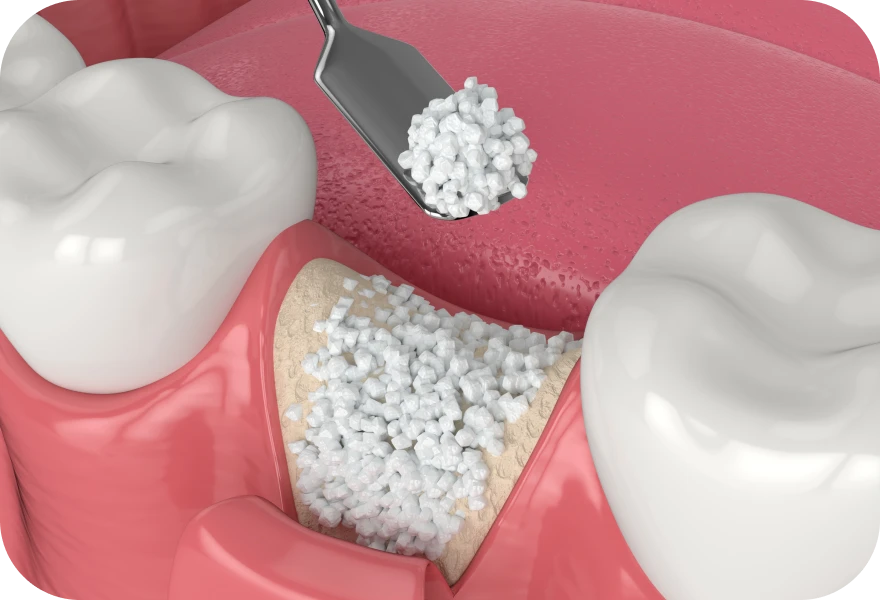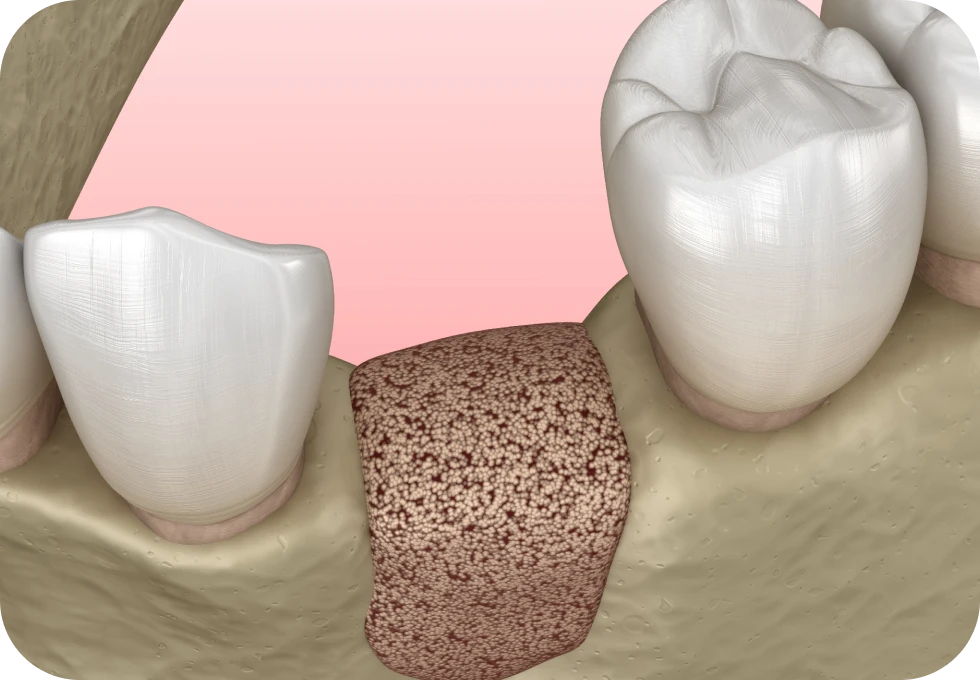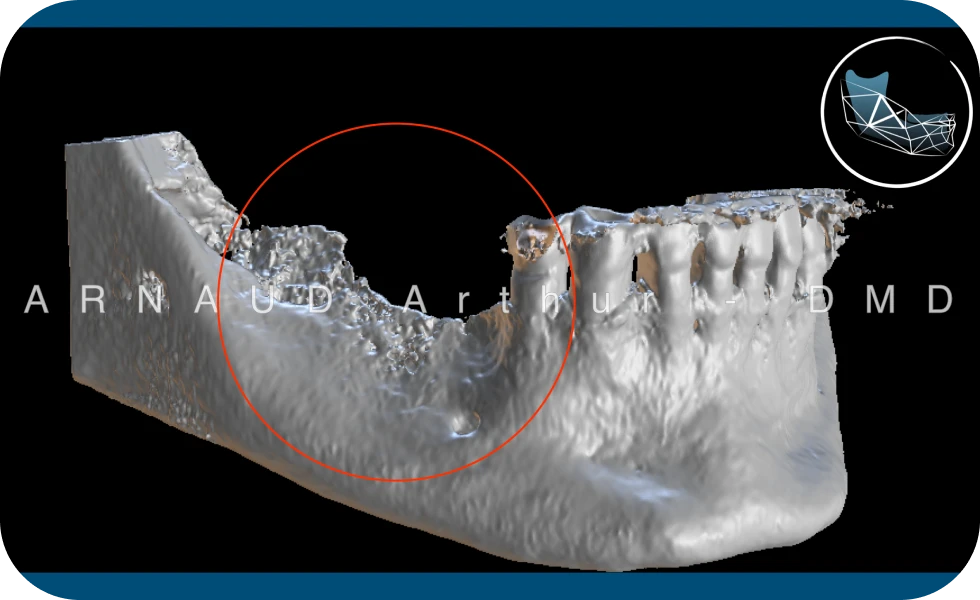Bone grafting
Facial fractures, congenital malformations, periodontitis, dental infections, bone cysts and tumors, or teeth missing over a long period of time can cause jawbone atrophy or resorption.
This often results in poor bone quality and quantity suitable for dental implants, as well as long-term displacement of remaining teeth and changes to facial structure. Most patients in these bone-deficient situations are not candidates for dental implants.

By performing a bone graft on the affected area, this not only gives the opportunity to place implants of appropriate length and width to replace missing teeth, but also gives a chance to restore functionality and aesthetic appearance with fixed teeth.
Many patients who wish to receive dental implants or other tooth replacement treatments require bone grafting.
If you’re looking for a non-removable solution to restore missing teeth, or if you want to prevent bone loss after tooth extraction, known as atrophy, bone grafting can be part of your treatment plan.
Why perform a bone graft?
Natural teeth are integrated into the jawbone and stimulate the jawbone through chewing. When an adult tooth is removed and not replaced, deterioration of the jawbone automatically occurs. Once the tooth is removed, the alveolar bone, or the part of the jawbone that anchors the teeth in the mouth, no longer receives the necessary stimulation and begins to resorb naturally.
The rate at which the bone surrounding the tooth loses its volume and the extent of bone loss vary considerably from one individual to another. However, most loss occurs within the first eighteen months after extraction and will continue progressively throughout your life.
How does bone grafting work?
During your first consultation, additional examinations such as a CT scan of your jawbones are carried out, enabling bone atrophy to be accurately diagnosed in all three spatial dimensions. This allows us to measure and determine bone loss, so that we can suggest the most appropriate techniques.


There are many types of bone grafting procedures, most treatments involve taking bone grafting material and placing it in areas lacking the right quality or quantity of bone. Bone grafting is a common procedure for patients who are missing one or more teeth and whose jawbone volume has melted over time. Bone graft material can come from a variety of sources: animal, human or your own.
After surgery, a healing period is necessary during which your body will integrate the graft material, creating mature, strong bone for dental implants.
What types of bone can be used?
Autogenous bone: autogenous grafts, also known as autografts, are made from your own bone, harvested from elsewhere in the body. The bone is usually taken from the lower jaw at the level of the wisdom tooth or chin.
Autogenous bone grafts have the advantage of a living material containing cells capable of producing bone, with a low risk of rejection. The main disadvantage is the need for an additional procedure to harvest this bone. Depending on the patient’s state of health, a second procedure is not always recommended.
Allogeneic bone: from a living human donor. The bone is treated using a process that preserves only the bone matrix. Allogeneic bone does not produce new bone, but serves as scaffolding and is colonized by the patient’s own cells.
Xenogeneic bone: derived from an animal, usually the cow. The bone is processed at very high temperatures to avoid any risk of immune rejection or contamination. Like allogeneic transplants, xenogeneic transplants serve as a support for the patient’s own bone cells to develop and fill the void. Allogeneic and xenogeneic bone grafts have the advantage of not requiring a second procedure to harvest your own bone, as is the case with autografts.
However, as these options lack the bone-forming properties of autografts, bone regeneration may take longer than with autografts and have a less predictable outcome.
The type of bone used depends on a number of factors that will be analyzed during the consultation: type of bone graft, quantity of bone to be reconstructed, patient’s general state of health, first bone graft or repeat of a failed one, smoking…
What type of bone graft do I need?
Many bone augmentation procedures are available prior to dental implant placement, and can be used to preserve bone after tooth extraction, or to restore bone that has been lost or damaged, even years after tooth extraction. Depending on your general state of health, the medical treatments you are taking and the CT scan performed during your consultation, Dr. Arnaud will suggest the most appropriate bone graft for you.
There are several types of bone grafts:
- Alveolar preservation: during tooth extraction, if a dental implant is not possible at the same time (due to active infection, excessive bone destruction, cyst, etc.), a bone graft is placed in the empty tooth socket to accelerate healing and preserve bone volume for subsequent implant placement. Once the bone graft has healed properly and integrated with your natural bone, a dental implant can be placed to replace the missing tooth.
- Ridge bone augmentation: dental implants require a certain height and width of bone for successful placement and maximum lifespan. If the bone that surrounds and holds your teeth (called the alveolar ridge) has resorbed too much (in height or width), we recommend bone grafting prior to implant placement.
- Sinus lift: the maxillary sinuses are behind your cheeks and above your upper jaw teeth. These sinuses are empty cavities inside the facial bones, filled with air and connected to the inside of the nose. Some tooth roots (such as premolars or molars) may protrude into the maxillary sinuses. When these teeth are removed, there is often only a thin bony wall separating the maxillary sinus from the mouth. When the sinus wall is very thin, it’s impossible to place dental implants in this area, because dental implants need bone to be held in place.
A sinus lift is one of the most common bone grafting procedures for patients with bone loss in the upper jaw. The procedure aims to increase the bone level beneath the floor of the maxillary sinus above the bone crest. This allows dental implants to be placed and fixed in the newly created bone.
Depending on the level of bone resorption at the outset, a sinus lift can be performed before or during the placement of dental implants.
These bone grafting procedures are generally performed under local anesthesia, although some situations require general anesthesia, depending on the size of the graft to be performed.

